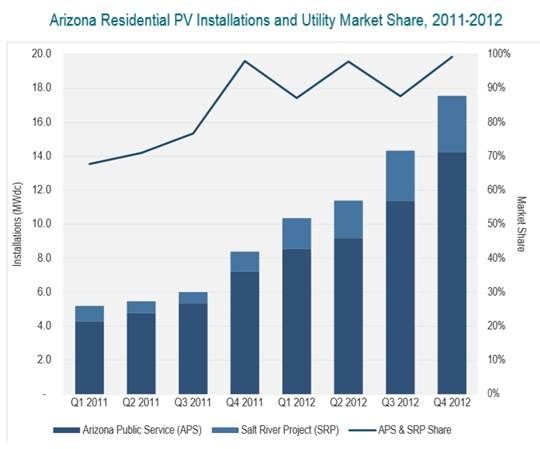The solar industry in Arizona is beginning to register the hurt from aggressive policy decisions made by the state’s energy commission, as Greentech Media heads to Phoenix for its sixth annual Solar Summit, April 22-24.
In January, the Arizona Corporation Commission (ACC) put an unannounced $38.3 million hit on the state’s photovoltaic (PV) solar industry when it eliminated performance-based incentives (PBIs) provided to commercial solar system buyers by the state’s two investor-owned utilities (IOUs). It also drastically reduced the upfront incentives (UFIs) provided by the IOUs to residential solar system buyers.
Arizona Public Service (APS) was scheduled to reduce its PBIs for commercial systems to $20.8 million for 2013. Tucson Electric Power (TEP) was scheduled to go to $10.5 million. Both will now go to zero.
In addition, a scheduled $400,000 allotment for APS UFIs was cut to $100,000, and a scheduled $1.7 million set-aside for TEP UFIs was cut completely.
The APS residential UFIs were scheduled to go to $6.96 million. That was cut to $2.65 million. TEP’s residential UFIs were cut from $1.46 million to $744,000.
The UFIs were paid at the rate of $0.10 per watt. The PBIs were based on competitive solicitations and were expected, due to increasingly competitive solar costs, to fall to about $0.05 to $0.06 per kilowatt-hour this year.
“The broader commercial solar market is essentially lifeless in Arizona, from our perspective,” Mainstream Energy/REC Solar Legislative Director Ben Higgins said.
“We are working to close projects with previous incentives and working a backlog in the field,” Wilson Electric Solar Division Manager Mark Holohan reported. “We don't have much to say to non-taxpayers unless they qualify for an APS School and Government incentive.”

Source: GTM Research 2012 U.S. Solar Market Report
“We have slowed down,” Technicians for Sustainability owner Kevin Koch said. “but we still have commercial work lined up with last year's incentives until October of this year.” Like Holohan, Koch said his company is “turning away” leads on commercial systems for “churches and municipalities” that cannot take advantage of the federal investment tax credit (ITC).
“We are now being forced to focus on niche opportunities where solar can compete with utility power without any incentive,” Natural Power and Energy Director Rob Dallal reported.
That there are such opportunities, Dallal noted, demonstrates the solar industry’s cost-cutting success and highlights the misguidedness of “cutting the industry off at the knees.”
Arizona’s solar industry is not asking for “endless subsidy,” Dallal explained. “Subsidies are used in infant industries of strategic importance, to allow them to reach the critical scale they need to operate without subsidy. Solar is no different, and we are ahead of schedule. But the ACC’s decision to cut support for large-scale distributed solar was just one to two years too soon.”
The entirely Republican ACC commissioners’ rationale for the cuts, explained SolarCity (NASDAQ:SCTY) Governmental Affairs Director Meghan Nutting, was that they will reduce the Renewable Energy Standard and Tariff (REST) premium added to Arizona ratepayers’ utility bills to fund solar. But the REST premium is capped at $4.00 per month, and calculations by Arizona solar advocates concluded the PBI cuts will save APS ratepayers no more than $0.02 to $0.06 per month.
Solar Energy Industries Association (SEIA) VP Carrie Cullen Hitt called the ACC action “a step backwards for Arizona's longstanding commitment to economic development, free markets and expansion of clean energy resources,” as well as “particularly troubling at a time when Arizona faces challenges including water usage and shuttering of coal facilities.”
“Ratepayers will save virtually nothing,” Dallal observed, “as they will continue to pay for large-scale solar plants owned by the utility. So, the subplot of the ACC decision was in fact its support for the regulated monopolies, at the expense of a competitive market which was driving meaningful cost reductions. Arizona’s competitive advantage is the sun.”



